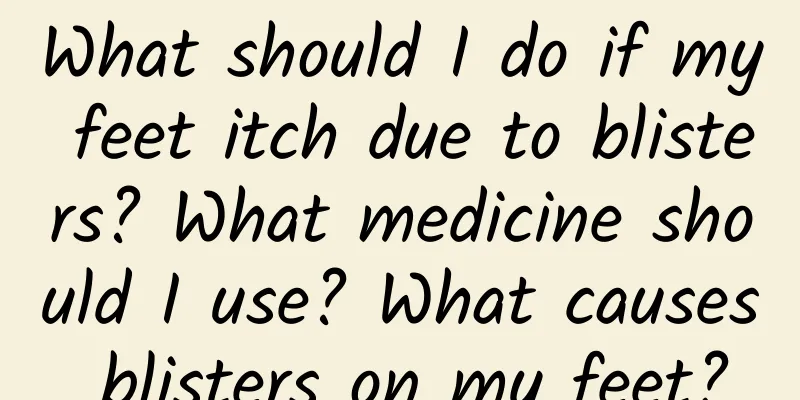What should I do if my feet itch due to blisters? What medicine should I use? What causes blisters on my feet?

|
What should I do if blisters on my feet are very itchy? Especially in the hot summer, the feet are very easy to sweat, which makes the skin more fragile. Wearing slightly tight shoes will cause blisters on the feet, which are very itchy. What should I do? What can I do if the blisters on my feet are very itchy? What medicine can I use to stop itching blisters on my feet? Let's take a look at it with Encyclopedia Knowledge Network. Blisters on the feet are usually caused by athlete's foot, which is a skin disease caused by fungal infection. Patients with tinea manuum usually have athlete's foot, which is contagious. It is also easy to infect each other when using public baths, public slippers, foot basins, and towels. Don't think that athlete's foot will heal without treatment. Athlete's foot is also a disease that requires long-term treatment. Causes of blisters on feetTinea pedis is also called athlete's foot. Excessive sweating on the soles of the feet is the main factor causing tinea pedis. In hot summer, the sweat glands on the feet secrete more, and the soles of the feet are moist. The moist environment is conducive to the reproduction and growth of fungi, which makes tinea pedis more likely to occur. Trauma to the skin of the feet destroys the skin's defense function, which is also one of the factors causing tinea pedis. Diabetic patients are also prone to tinea pedis because of the lack of insulin, which leads to metabolic disorders and increased sugar content in the skin, resulting in decreased resistance. Abuse of antibiotics, long-term use of corticosteroids and immunosuppressants, etc., can cause an imbalance in the normal flora of the skin and increase susceptibility to tinea pedis. The onset of tinea pedis is also related to lifestyle habits. Bad hygiene habits often increase the incidence of tinea pedis. Some people do not pay attention to foot hygiene and the condition of shoes and socks, which provides a good breeding ground for fungi. Some people also like to touch their toes with their hands, which damages the skin of the feet and spreads tinea pedis. If someone in the family suffers from tinea pedis and does not receive proper treatment and comes into close contact with others, it will cause contact transmission. Items used by tinea pedis patients are often not disinfected, and healthy people are also susceptible to infection after using them. Clinical manifestations of blisters on feet1. Bullous : It mostly occurs in summer. Symptoms include rice-sized, deep blisters between toes, on the edge of the foot, and on the sole of the foot. They are scattered or distributed in groups. The walls are thick, the contents are clear, and they are not easy to break. After a few days, they dry and desquamate, and fuse together to form multi-chambered blisters. When the walls are torn off, a honeycomb base and bright red erosion surface can be seen, which causes severe itching. 2. Erosive : manifested as local epidermal stratum corneum maceration and whitening. Due to constant friction when walking, the epidermis falls off, revealing a bright red erosion surface; in severe cases, the skin between the toes and the junction of the toes and the soles can be involved, with severe itching, mostly between the 3rd, 4th, and 5th toes. Common in people with multiple eczema. 3. Scaly keratosis : Symptoms include thickening, roughness, and scaling of the skin on the soles, edges, and heels of the feet. The scales are in the form of flakes or dots and fall off repeatedly. In winter, cracks appear between the toes, and in summer, blisters form, which are painful. Scratching often causes secondary infection, and complications include impetigo, lymphangitis, lymphadenitis, cellulitis, erysipelas, sepsis, and other diseases. Taboos for blisters on feet1. Avoid damp feet . Keeping feet clean and dry is the premise for preventing athlete's foot. Patients with athlete's foot should wear breathable shoes and socks in summer, and avoid wearing rubber shoes, sports shoes, and even more so, wearing non-breathable shoes barefoot; when drying your body after taking a shower, be sure not to ignore your feet; do not walk barefoot on carpets or in bathrooms. 2. Avoid alkalinity . Avoid using irritating chemicals such as alkaline soap when washing your feet. People with tight toes can use toilet paper to sandwich them between the toes to absorb water and ventilate to keep them clean. 3. Avoid spicy food. Avoid eating peppers, raw onions, raw garlic and other foods that easily cause sweating. It is best not to drink alcohol. Eat more nutritious and easily digestible foods, and eat more vegetables and fruits high in vitamins. 4. Avoid sharing washing supplies . Avoid using public towels and slippers in public places such as swimming pools and bathrooms. Shower and rinse after swimming, dry with a clean towel, and do not share shoes and socks with others to avoid reinfection. Precautions for blisters on feetPay attention to cleanliness, keep your skin dry, keep your feet clean, wash them several times a day, and change your socks frequently. Foot basins and foot towels should be used separately to avoid infecting others. It is not advisable to wear non-breathable shoes such as sports shoes and hiking shoes to avoid excessive foot sweating and worsening foot odor. People with tight toes can use straw paper to sandwich them or choose split-toe socks to absorb water and ventilate. Actively eliminate the triggering factors, such as foot sweating, athlete's foot, etc. Do not eat foods that easily induce sweating, such as peppers, raw onions, raw garlic, etc. The mood should be calm. Excitement can easily cause excessive sweating and aggravate athlete's foot. Athlete's foot is a contagious skin disease. You should avoid scratching to prevent self-infection and infection. While taking medication, the shoes and socks worn by the patient should be disinfected. They can be exposed to sunlight or washed with boiling water. It is best to use a piece of cloth dipped in 10% formalin solution to stuff the shoes, put them in a plastic bag and seal them for 48 hours to achieve the purpose of sterilization. Some people think that tinea pedis is a health disease and that if it is cured, other diseases will occur. In fact, this is not the case in medicine. Some people lose confidence due to repeated infections, so it is also very important to use separate towels, basins, slippers, etc. What to do if blisters on feet are itchyGenerally speaking, blisters on the feet are caused by fungal infection and tinea pedis. Therefore, it is recommended that you use the following methods. These methods can basically treat the symptoms and have a better effect on the problem of blisters on the feet. 1. Apply ketoconazole ointment externally. 2. Soak your feet in 3% 84 disinfectant for 20 minutes, twice a day. Then apply Daconin cream. 3. After washing your feet, apply Dakning ointment to the affected area. 4. Soak the affected area in vinegar and water for 20 minutes every day, then apply Pervisone ointment to the affected area for treatment. A good effect can be achieved within two weeks. 5. To deal with the problem of blisters on the feet, Wuji ointment or erythromycin can both have a certain effect. 6. Apply chloramphenicol eye drops externally. I heard it works, but it may not be effective. 7. 999 Psoriasis Cream also has certain effects, but it is best used in combination with other drugs. 8. I heard that soaking your feet in Zuguang powder is also quite effective. 9. Skin care lotion can remove heat, cool blood and remove dampness, kill insects and relieve itching. It can also be used to deal with blisters on the feet. 10. Alum or alum powder can remove sweat and stop perspiration, helping to speed up recovery. 11. It should be noted that it is OK to release the water in the blisters, which will help them heal faster. However, before squeezing the blisters, you must disinfect the affected area with iodine fluoride or white wine (hydrogen peroxide is also OK), wash your hands, and then squeeze the blisters. After squeezing the blisters, you should wipe the affected area with 2-3% iodine (hydrogen peroxide is also OK), and then apply the usual medicine to the affected area. |
<<: What medicine should I take for heat stroke? Symptoms, prevention and treatment of heat stroke
>>: How to prevent tick bites? What are the symptoms of tick bites?
Recommend
What causes dark brown blood during menstruation?
If the menstrual blood is black during menstruati...
What to do if you have vaginal pain after childbirth
Pregnant women must be very happy right after giv...
What can women with anemia eat to replenish blood quickly?
I believe many people know that iron deficiency c...
What should I do if breast proliferative changes are combined with acute inflammation?
Breast hyperplasia is a very common breast diseas...
Bleeding after taking birth control pills for a few days
In life, some female friends will experience blee...
What causes slow follicle development?
What is the reason for slow follicular developmen...
Green vaginal discharge after pregnancy
Many women are concerned that their discharge wil...
How to lower transaminase during physical examination? Will drinking water on the day of physical examination increase transaminase?
Checking transaminase is an important indicator o...
Why don’t you feel heartbroken after a breakup? Does not feeling heartbroken after a breakup mean you’ve never loved?
Keep praising yourself, write down your strengths...
Dongru's exact location and function
Rugen acupoint belongs to the liver and gallbladd...
What does a negative syphilis treponema antibody mean?
Nowadays, young people always don't care abou...
How to restore cervical hypertrophy to normal
Cervical hypertrophy is a form of gynecological i...
What items should be checked before abortion?
Regarding the routine examination before abortion...
Research Progress丨Positive results of melanin vaccine revealed, is the vaccine for preventing cancer recurrence a therapeutic or preventive vaccine?
April 15th is National Anti-Cancer Day, but there...
What if I have brown discharge a week before my period?
Menstruation is the physiological phenomenon that...









